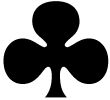Chances do Recur
|
 Q 7 6 4 Q 7 6 4 |
|
 K Q 6 K Q 6 |
|
 Q 9 4 2 Q 9 4 2 |
|  Q 9 Q 9 |
 5 5 |
|
 J 2 J 2 |
 J 10 9 8 3 J 10 9 8 3 | |
 A 7 5 2 A 7 5 2 |
|
 10 8 5 10 8 5 |
|  ------ ------ |
 A 6 5 4 A 6 5 4 | |
 K J 10 8 7 3 2 K J 10 8 7 3 2 |
|
 A K 10 9 8 3 A K 10 9 8 3 |
|
|
 4 4 |
|
|
 A K J 7 6 3 A K J 7 6 3 |
Opening lead: A of clubs |
|
 ------ ------ |
Vul: E-W |
| South | West | North | East |
1  |
Pass |
3  * * |
4 |
6  |
Pass |
Pass |
Dbl |
| All | pass | | *Alerted |
However you slice it, opportunities for the Lightner double do recur, and it's almost a cost-free convention. It doesn't eat up any space or wipe out a bid you'd often want to make. Since writing up my first comments, wherein I said that you'll probably first hear that the Lightner double calls for dummy's first bid suit, and subsequently find some sophisticate telling you, No, it calls for an unusual lead. I went on to say that until you get real good, I think you'd do well to stick to the first and very unambiguous take on the Lightner double, "unusual" being a little too vague to give a whole lot of direction. Since then, I came across a professional columnist's statement that the double calls for a lead of "dummy's first bid suit", without any malarky about "unusual," and I felt heartened.
I'd also like to point out that with a void in that first bid suit and an ace, East was employing the double correctly. A void isn't good enough against a six bid. You have to be able to say, "Partner, if you'll lead this suit, I think we can beat the slam." But wait? Suppose declarer's singleton had been a club instead of a heart. Yikes! Then you're not going to beat the contract on a diamond lead, and shift to the A of hearts, now, are you? But no bidding scheme is perfect, which is part of the game. You only go for likelihood, and here, you can see, a diamond lead would have beaten the contract, for a whopping 1300-point swing and that ain't hay. You can live with a few misfires if you get 10 or 15 zingers for every one that misfires, no?